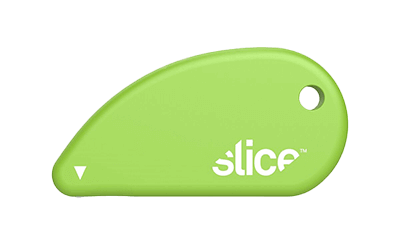What Is a Safety Cutter?

A safety cutter is a tool used for cutting thin paper, cloth, and sheets.
The most common cause of cutter accidents is cuts caused by blades that are left out. Safety cutters are designed to reduce these cutting accidents.
Ordinary cutters leave the blade out after cutting, but safety cutters prevent accidents by automatically returning the blade to its original position or by not leaving the blade exposed. By using safety cutters suited for the intended use, you can improve the safety and accuracy of your work.
Uses of Safety Cutters
Safety cutters are used in a wide range of fields, from schools, hobbies, and DIY to stores, offices, and professional workplaces.
In stores and supermarkets, in particular, they are often used to prevent unexpected cut accidents when frequent unpacking is required. They are also introduced in schools for the safety of children.
Principle of Safety Cutters
Safety cutters are designed to reduce the risk of cuts caused by the blade. They are designed to minimize blade exposure as much as possible.
In order to reduce the exposure of the blade, there are two types of cutters: those with a blade that automatically returns to its original position and those without an exposed blade.
1. Safety Cutter With a Blade That Automatically Retracts
The safety cutter has a spring attached to the part where the blade is attached, so the blade automatically retracts into the body when the cutting is finished and the blade is away from the object.
2. Safety Cutter With No Exposed Blade
The blade is housed inside the body and is not exposed, preventing cuts caused by the blade. A slit-shaped depression in part of the body is where the blade is stored. Cutting is performed by sliding the object to be cut into the slit.
In addition to “reducing blade exposure,” safety cutter blades have a single blade. When the blade of an ordinary cutter is worn out, the tip of the blade is broken off and replaced with a new one, but the blade of the safety cutter is a single blade. By eliminating the need to break the blade, it reduces the number of accidents that can occur when the blade is broken, and prevents unexpected accidents caused by excessive blade protrusion. It also reduces the risk of blade breakage and contamination.
Types of Safety Cutters
1. Spring Type
A spring is built into the body of the cutter, which automatically retracts the blade into the body when the blade is separated from the object to be cut.
2. Hook Type
This type of cutter has a hook-shaped body like a beak and “scoops” the cutter. The blade is almost completely covered by the body, providing excellent safety. This type is suitable for unpacking work because it can open a box without cutting its contents.
3. Grip Type
The blade comes out only when the grip is held. When the grip is released, the blade is retracted into the body. Grip type cutters are suitable for thin rubber sheets, films, and other hard-to-cut materials as well as paper.
4. Ceramic Blade Type
The cutter blade is made of ceramic and has a rounded blade edge, making it less likely to cause a cut accident even if it comes in contact with the hand. Also, the blade is more durable than the metal blades, so the frequency of blade changes can be reduced. Less frequent blade replacement is one of the measures to reduce accidents.
5. Type With a Cord Hole to Prevent Falling
A hole is provided at the rear of the main body to which a cord or string can be attached to prevent accidental dropping or loss. 6.
6. Ambidextrous Type
Many models are available for both right-handed and left-handed users. Using the type that matches your dominant hand will also help prevent accidents.
7. Single-Use Type
Since there is no need to replace the blade, there is no danger of accidental contact with the cutting edge, resulting in a cut or wound.
Other Information on Safety Cutters
1. How to Use Safety Cutters
Even with safety cutters, it is important to use them correctly to reduce the risk of accidents.
- Do not hold the cutting edge out too far.
- Use in the correct posture
- Position your hands in a safe position
- Work carefully and without haste
- Use the appropriate type of safety cutter for the object.
- Return the blade to its proper place of storage after use and dispose of the replacement blade safely and immediately.
- Replace blades as soon as possible after they become difficult to cut, as this can lead to accidents.